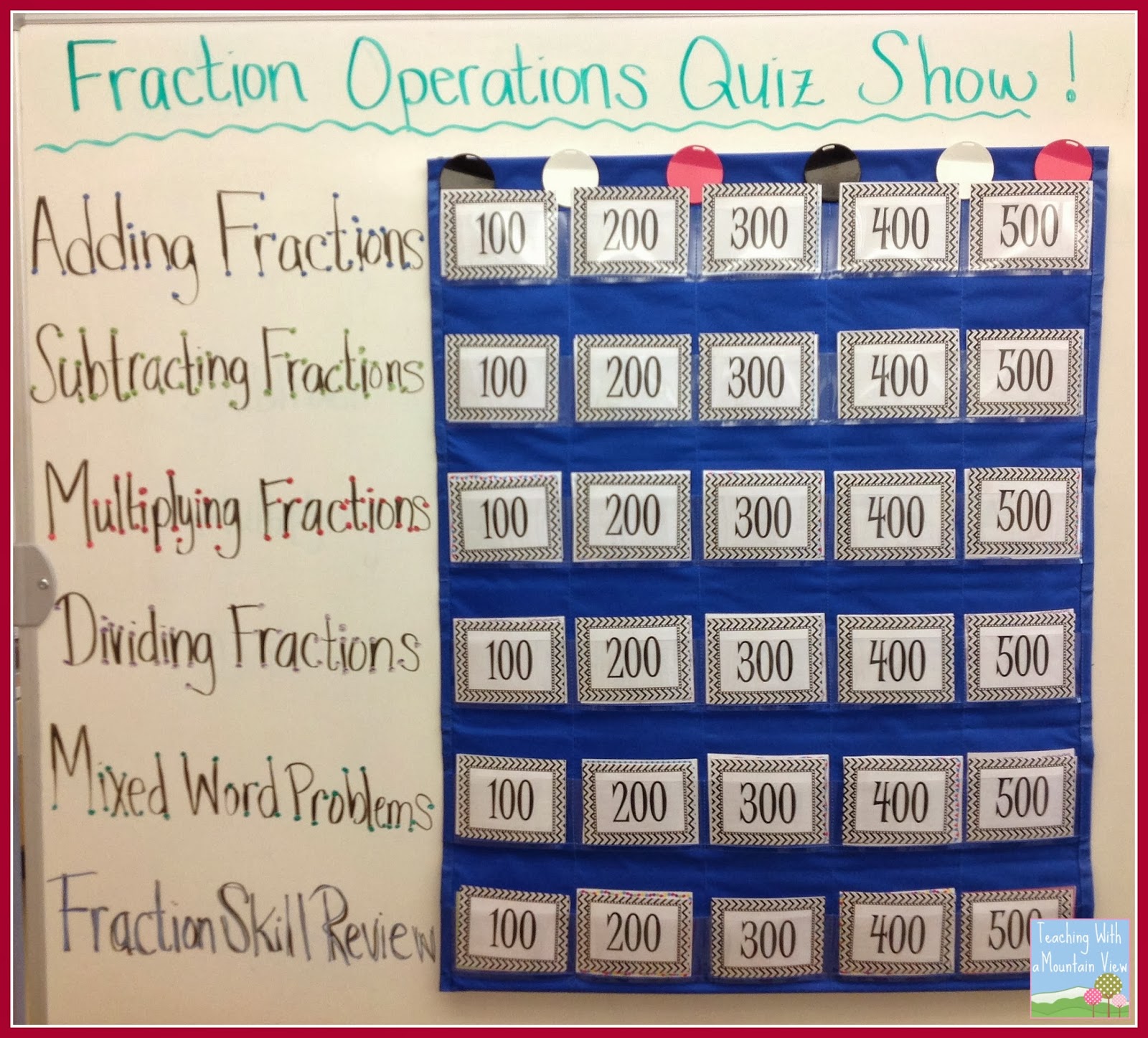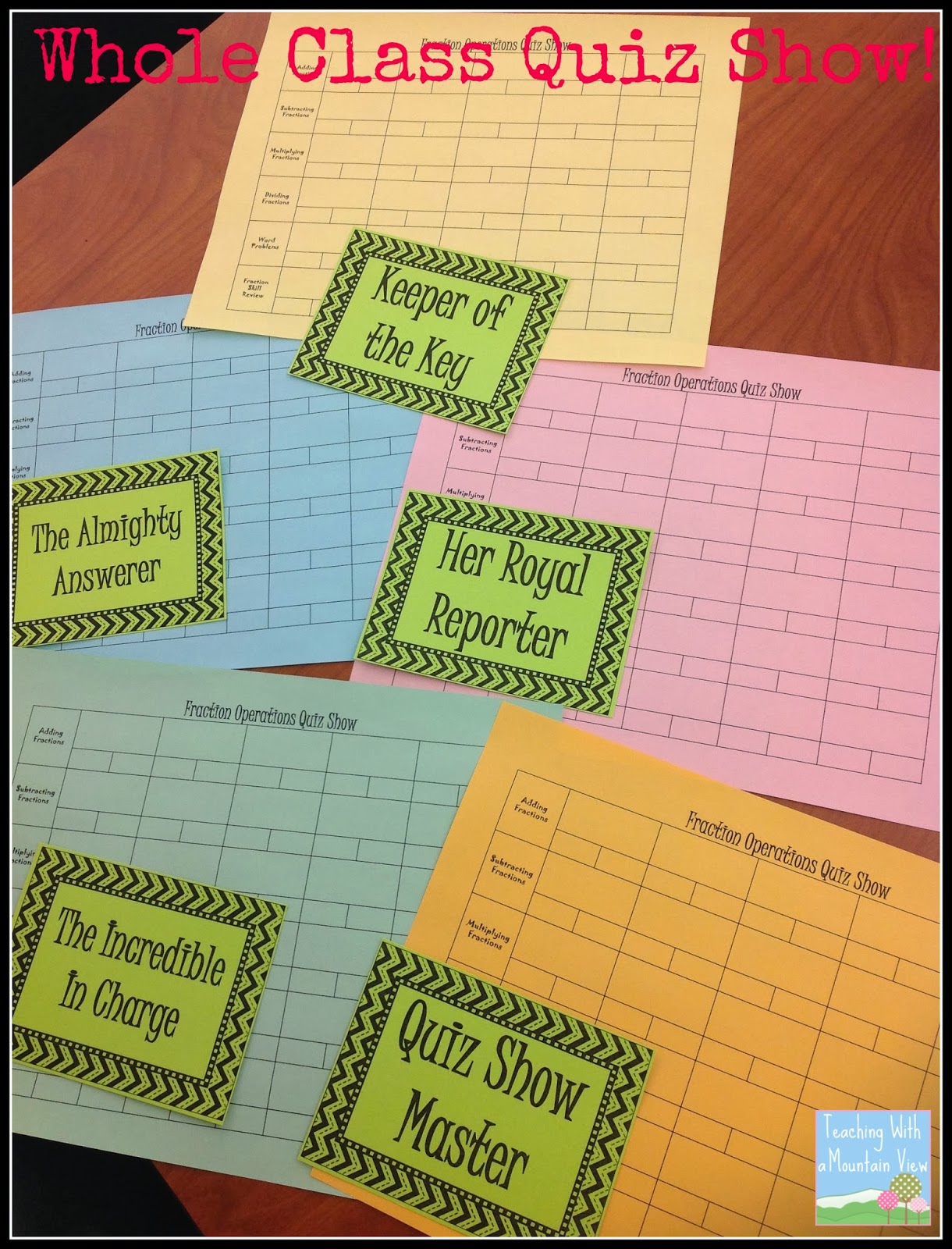I was on the hunt for a pocket chart, and one of my sweet colleagues had one that was MADE for this kind of thing. It is only $4 on Amazon HERE. I didn't need the question cards it came with, but it's perfect for the size of my quarter page task cards.
I set up the game board to include a wide variety of fraction problems including all of the operations, mixed skill review (comparing, simplifying, mixed numbers, etc.) and word problems. I put a task card in each slot, with increasing difficulty and level of critical thinking needed to answer the problem. I covered each card with a point value ranging from 100-500.
Here is a look at my board...
 |
| Here is a look at the board before I put the point value cards on top. |
I knew I needed a way to make sure everyone was involved in the game and that each group wasn't only as strong as its strongest member and vice versa. So, I changed things up a little bit. Each group of students (I had 5 groups) had a silly card (named so by my students). This silly card rotated through the group each round, and whoever had the card was in charge of reporting out their answer, and being able to explain how they arrived at their answer. The group had to work together to solve the problem, but only the person with the card could go up and present the answer.
I got a little goofy with their titles, but they thought they were hilarious and lauged at me a little bit. :)
I also made a recording sheet that mirrored the gameboard. Underneath each answer space was a smaller space divided in two sections. In one section, they had to initial who was in charge of the answer, and on the right side they recorded their points.
I also kept them all engaged by giving each group a chance to get points each round, regardless of whether or not they were first done with the answer. This was also me being sneaky and adding in some more multiplying fractions, and it worked! More about the points later...
I started by selecting the first category and value and then the winner of each round got to select it from that point on. I did a 3,2,1 countdown and put the task card on the document camera for the students to read and solve themselves.
 |
| Here's a look at one of the cards being projected up on the white board. You can see the others we had already done underneath this one. |
When the reporter and the group had solved the problem, they wrote their answer on their answer sheet. The reporter had to walk (not run, slide, jump, or dive) up to the board and stand on one of five spots. The first person to be done stood on spot one, second on spot two, and so on and so on. I loved this part because it got them up and moving, and different combinations of kids were at the front each time.
 |
| A star on my (very dirty) carpet for a representative from each group to stand on when they finished the card. |
I also wanted to keep the kids guessing about who was going to have to present their answer (again, I wanted EVERYONE to have a full understanding of the problem we were working on). So, I put the numbers 1-5 in a jar and once I had a representative from each of the five groups standing on a spot, I drew a number and the person standing on that star had to share their answer and how they arrived at their answer.
I mentioned before that each group could get points each round if their answer was correct. Here is how we did that. If the student standing on star 1 (meaning they got the answer done and up to the board first) got it correct, they got the full value of the points. If the person standing on star 2 got it correct, their group got 4/5 of the points for that card, and so on.
Not only did they have to do more multiplying fractions, this helped me to emphasize that, no matter what, accuracy was more important than speed. It was better to be the 5th group done and get 1/5 of the points than to be the 1st group done and get it wrong and get no points. As I mentioned above, they kept track of their points on their sheet, directly under the problem they were solving.
We are finishing up the game tomorrow, when they will add up all of their points, and we will see who was the winner for each category and also for the whole game. The kids absolutely adored playing this, and I think they appreciated the few little twists I put on it to get everyone involved and to get the kids up and moving (we also rotated seats throughout the course of the game so that nobody had an unfair proximity advantage). Of course, it's not fail proof, but the kids were engaged and practicing their math.
 |
| This picture cracks me up because I could not get a picture of the kids working that didn't have a blurry hand or pencil it in. They were working like pros on these problems! |
You can truly do this game with any concept, any set of task cards, or even create your own problems, but we happened to be reviewing fractions. Here are the task cards I used in each section. They are differentiated so that there are cards appropriate for values 100-500.
You can download the number cards and the recording sheet I used HERE. It's nothing fancy because I wanted the students to have plenty of room to do their recording. The frames for the numbers are from Pink Cat Studio. Love her cute frames and borders!
If you're looking for a standard review for operations with fractions, you can download my FREE quiz or review from my TpT store. I used this last year with great results! Download it HERE.






.JPG)





